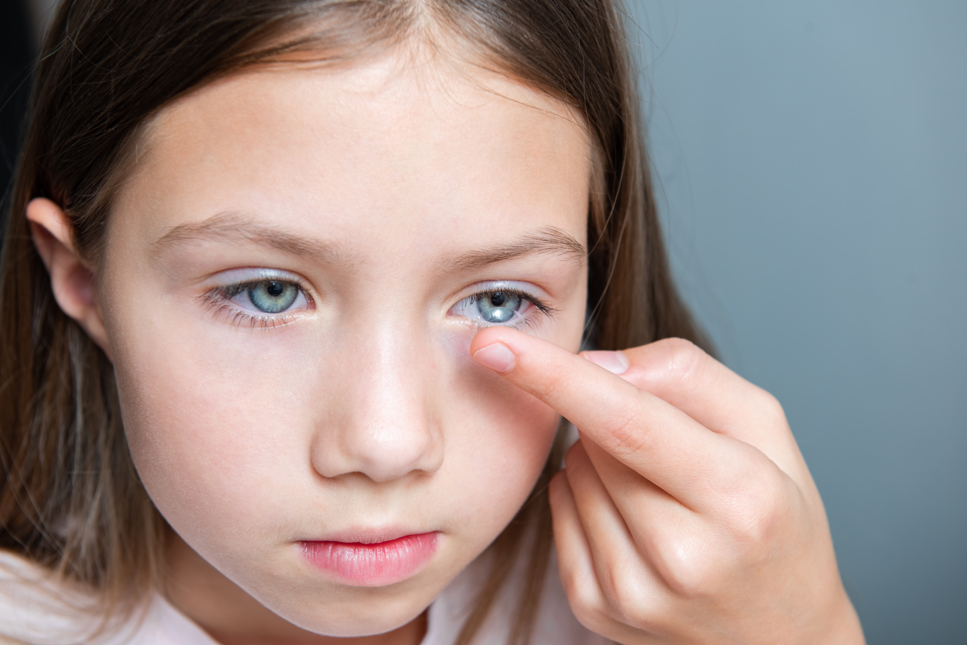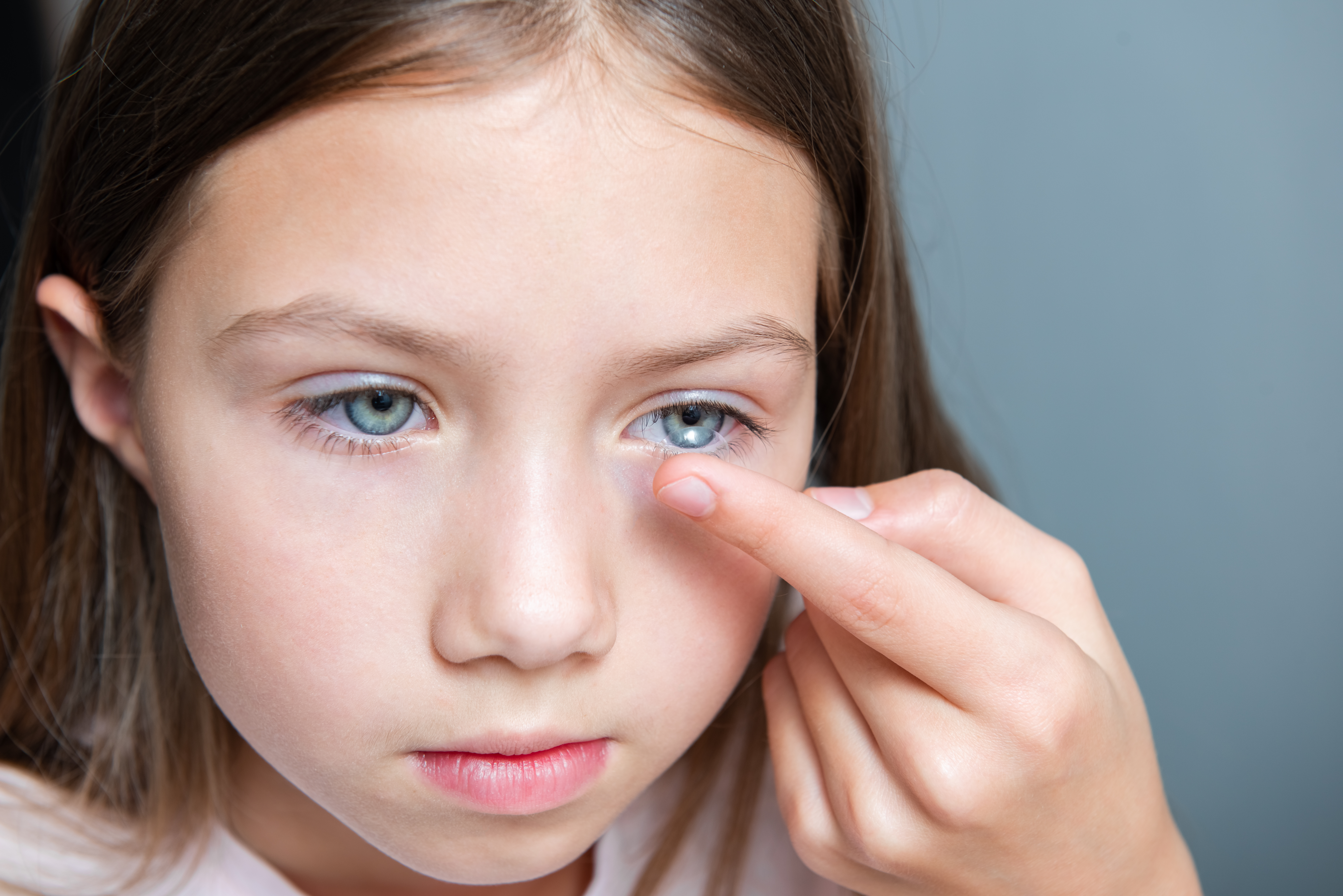Contact Lenses for Children
You may find yourself asking the question: "Are contact lenses for kids an option?"
As parents and caregivers, we only want the best for our children, especially when it comes to their eye health and overall well-being.
In this article, we'll take a look into the world of contacts for kids and explore the benefits, risks, types available, and factors to consider when coming to this crossroads; helping you make a more informed decision!

When Can Kids Wear Contact Lenses?
Opticians may recommend the introduction of kids' contact lenses from as early as 8 years old. Some, on the other hand, may not recommend them until the age of 12 or older. Determining when children wear contact lenses is a tricky one as there are a few things to consider, such as:
-
Age and maturity: While age is just a number, do take into account the age and maturity level of your child. Keeping contact lenses clean and safe requires a level of responsibility. Younger children may not have developed these fundamental traits yet, which may impact (and prolong) your decision.
-
Individual characteristics: Your child's unique personality, habits, and level of personal hygiene are factors to consider. Contact lens wearers need to be responsible when taking care of their contact lenses to ensure they are safe and clean.
Common misconceptions and concerns
Here are a few notable misconceptions and concerns about children wearing contact lenses.
Complex lens care
A common misconception that many parents worry about is that kids won't be able to manage the intricate care routines associated with contact lenses.
The reality is, with modern-day advancements, the use of daily disposable contact lenses eliminates the need for cleaning and storage.
Comfort and safety
Parents and caregivers often worry about the level of discomfort and/or potential eye infections that their children may experience when wearing contact lenses.
The truth is, that modern-day contact lenses are made from comfortable, breathable, and soft contact lens materials which reduce these risk factors.
Risk of eye damage
Many believe that contact lenses may worsen or even damage their child's developing eyes.
The reality is that contact lenses are safely prescribed and fitted (initially) by opticians. Going for regular check-ups ensures that any issues are quickly addressed.
Impact on self-esteem
Parents and caregivers often think that wearing contact lenses may make their children feel self-conscious, embarrassed, or uncomfortable in social settings.
However, most times, wearing contact lenses can actually boost a child's confidence as they do not need to wear prescription glasses. Wearing lenses may make a child feel more 'included' as the stigma of wearing glasses is removed.
Performance in sports
Many have the common misconception that contact lenses may hinder their child's performance in sports or have the risk of falling out.
In reality, contact lenses provide better peripheral vision than glasses do as they cover the entire eyeball. Soft contact lenses are less likely to fall out when compared to other types.
Choosing the Right Kids Contact Lenses: Types of Contact Lenses for Children
There are many different types of contact lenses on the market. And it's a bit daunting choosing the right lenses for your kid, right?
Contacts are fairly easy to get, as you can buy contact lenses online or get them directly from your child's optician.
Available types:
Soft contact lens
These are a popular choice of prescription contact lenses for kids, due to their comfort and flexibility.
These lenses are made from hydrogel (a water-based substance that has a soft consistency and moisturising properties) or silicone hydrogel (a flexible plastic that absorbs water) materials. They are hard at first but become soft once lubricated.
Benefits
-
Easier for the eyes to adapt to
-
Greater comfort
-
Better appearance
-
Less nighttime flare-up
-
Great for active lifestyles (i.e. sports)
Disadvantages
-
Higher risk of tearing when compared to other contact lens types.
-
Should the contact lens tear, the cornea could receive less oxygen.
-
Some individuals experience more dryness with soft lenses.
Daily disposable lenses
These lenses are made from silicone hydrogel and offer convenience and hygiene benefits. These are common contact lenses for kids. Children get to wear a fresh set of lenses every day without having to worry about cleaning and storage.
Benefits
-
Easy to use
-
Comfortable
-
No need for cleaning or storage
-
Less risk of eye infection
-
Great for children who battle with consistent lens care
Disadvantages
-
Not for extended use (as the name suggests)
-
Less durable when compared to other lens types
Rigid lenses
Rigid gas permeable lenses are hard contact lenses made from silicon materials. They are breathable, more durable and offer sharper vision. These are ideal for children suffering from astigmatism (an imperfection in the curvature of the eye resulting in blurry vision).
Benefits
-
Breathable
-
More durable when compared to soft contact lenses
-
Better vision quality
-
Less deposit build-up
-
Slows the progression of myopia (short-sightedness)
Disadvantages
-
Takes some time to get used to
-
Not as flexible as soft lenses
Orthokeratology lenses
Also known as Ortho-K lenses, these gas-permeable lenses are designed to be worn overnight. They temporarily reshape the cornea while correcting vision without the need to wear glasses during the day. These contact lens types can be used for children with specific vision challenges, such as near-sightedness.
Benefits
-
No need to wear glasses during the day
-
Slows the progression of myopia
-
Can prevent the need for prescription glasses
Disadvantages
-
Wearers must follow strict wearing-time guidelines
-
Vision improvements could be temporary
Safety and Comfort: Benefits of Kids Contact Lenses
There are several benefits of kids' contact lenses, especially if they are active and playing sports. These include:
-
Enhanced freedom of movement.
-
They encourage the child to become more responsible by keeping their contact lenses safe.
-
Clear and improved peripheral vision.
-
Reduced risk of accidents (and/or the risk of breaking their glasses).
-
Stable vision correction.
-
Weather-friendly.
-
Enhanced self-esteem and confidence.
-
Parental peace of mind.
How to Introduce Contact Lenses to Children
Introducing your child to their first pair of contact lenses can be a challenge, but it doesn't have to be! When kids start wearing contact lenses you'll find that it can be a rewarding experience for them.
Here are a few helpful tips that we have found work for most parents:
-
Keep communication open and honest with your child about the idea of wearing contacts. Answer any questions and concerns they might have to ensure they feel comfortable, safe and well-informed.
-
Use age-appropriate educational resources, such as YouTube videos or articles, to better explain the importance of kids' eye health as well as contact lenses and their benefits and proper care.
-
Get professional advice from eye care professionals to help you explain the concept of contact lenses and how to use them.
-
Consider trying out a disposable contact lens first. This will help your child get the feel for wearing them without being overwhelmed with cleaning and storage.
-
Teach your child about the importance of proper lens care and how poor hygiene habits can result in eye infections. Encourage them to let you know if they have any discomfort while wearing their lenses.
-
Motivate your child to wear contacts consistently and celebrate the small wins throughout their contact-lens-wearing journey.
-
As your child becomes more confident, gradually step back and give them full control.
-
Teach your child what to do in instances where a contact lens may get lost. We suggest they carry a spare pair of glasses with them at all times.
-
If your child displays discomfort while wearing contact lenses, it's recommended that they see their optician immediately.
Caring for Kids' Contact Lenses
-
Clean hands: Teach your child to wash their hands before inserting/removing each contact lens. This prevents dirt, oils and germs from transferring to the lens and eyes.
-
Gather supplies: Encourage your child to have everything they need for their contact lenses with them. Laying out lens cases, cleaning solutions and a dry towel can be a helpful start to this process.
-
Remove the lens: To remove a contact lens, your child should stand over a well-lit, clean surface, preferably in front of a mirror. Looking upwards, they should use two fingers to gently "open" their eyelids. Using their index finger (on the other hand), they can "slide" the lens down onto the lower white part of the eye and "pitch" it out. This should be repeated for the other eye/lens.
-
Rinse the lens: Once the lens has been removed from the eye and is in their hand, pour a few drops of cleaning solution onto both sides of the lens. Repeat this step for the other eye/lens. This is only applicable to non-disposable lenses
-
Store the lens: Your child should then store both lenses in the designated compartment box and fill it with fresh cleaning solution. Ensure that the lens case is closed properly and stored in a safe place overnight.
-
Daily care: Ensure your child empties and refills their contact lens case with fresh solution every day (i.e. after every use).
Expert Insights and Resources
-
Studies have shown that 67% of eye doctors feel kids under 8 years old should not wear contacts and should rather stick to traditional frames.
-
66% of eye doctors suggest that contacts can be worn for kids between 15 and 17.
-
London's Association of Optometrists recommends that daily disposable contacts are the preferred choice for children.
-
According to the British Contact Lens Association, 99% of contact-lens-wearing children (aged 13 to 17 years old) indicated significant improvements in their quality of life.
-
For children under the age of 16, parental consent is needed for them to wear contact lenses.
-
In 2018, an NHS University Hospitals Coventry and Warwickshire study showed that 4 out of 10,000 people who wear daily contact lenses had a serious eye infection within one year.
-
Regular eye check-ups are important and should be done at least once a year.
-
Ensure your child's contact lenses have UV protection. Research shows that the risk of cataracts and muscular degeneration can be reduced when children wear contact lenses with UV protection.
Booking an appointment with your child's optician hasn't been easier, by using Book An Eye Test's user-friendly directory platform. We can help connect you to trained professionals in your area, safeguarding your children's eyes for years to come!
Final Thoughts
As we end this article about the world of kids' contact lenses, it's clear that making the right choice for your child involves a blend of factors to consider. This ranges from their eye health and lifestyles to the types of lenses available and their benefits.
Remember, there's no magic formula for when children start to wear contacts. It comes down to whether or not your child is actually ready to wear them!
While contact lenses are emerging as the option that offers vision correction, clarity, and more freedom, the importance of regular check-ups are vital in safeguarding one of your child's most precious senses.
Related articles





